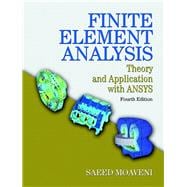For courses in Finite Element Analysis, offered in departments of Mechanical or Civil and Environmental Engineering.
While many good textbooks cover the theory of finite element modeling, Finite Element Analysis: Theory and Application with ANSYS is the only text available that incorporates ANSYS as an integral part of its content. Moaveni presents the theory of finite element analysis, explores its application as a design/modeling tool, and explains in detail how to use ANSYS intelligently and effectively.
Teaching and Learning Experience
This program will provide a better teaching and learning experience—for you and your students. It will help:
- Present the Theory of Finite Element Analysis: The presentation of theoretical aspects of finite element analysis is carefully designed not to overwhelm students.
- Explain How to Use ANSYS Effectively: ANSYS is incorporated as an integral part of the content throughout the book.
- Explore How to Use FEA as a Design/Modeling Tool: Open-ended design problems help students apply concepts.








